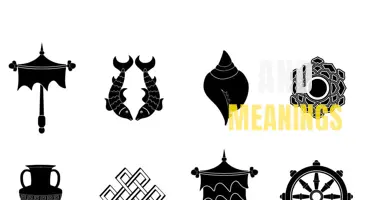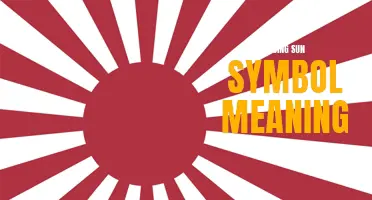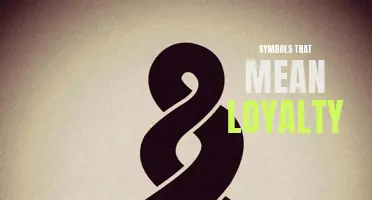
Colors have always evoked emotions, stirred our imagination, and influenced our behavior. From the vibrant red that ignites feelings of passion, to the calming blue that brings a sense of tranquility, colors have a profound impact on how we perceive the world around us. Throughout history, different cultures and societies have assigned meanings to various colors, weaving them into their traditions, art, and even language. Whether it's the regal purple of royalty or the pure innocence of white, color symbolism offers a captivating glimpse into the complexities of human perception and expression. In this article, we will delve into the fascinating world of color symbolism, exploring the hidden messages and ancient significances behind our favorite hues.
What You'll Learn
- What are the traditional color meanings and symbolism across different cultures?
- How do colors affect human emotions and behavior?
- How has color symbolism evolved over time?
- Are there differences in color symbolism between Eastern and Western cultures?
- How can businesses and marketers use color symbolism to influence consumer perceptions and behavior?

What are the traditional color meanings and symbolism across different cultures?
Color has always played a significant role in different cultures and societies around the world. Every color carries its own meanings and symbolism, which often vary across cultures. From vibrant reds to serene blues, each color has its own unique message and impact.
In many Western cultures, red is often associated with love, passion, and power. It commonly symbolizes courage, energy, and even anger. This is why red is a popular choice for romantic occasions, such as Valentine's Day. In contrast, white is usually associated with purity, innocence, and peace. It is often used in weddings and religious ceremonies to symbolize a fresh start or a clean slate.
In Asian cultures, red holds a different significance. It is seen as a symbol of joy, luck, and prosperity. Red is often used in traditional celebrations, such as Chinese New Year, to bring good fortune and ward off evil spirits. In contrast, black is often associated with death, grief, and mourning in many Asian cultures, as opposed to the Western association of black with power or elegance.
Green is commonly associated with nature, growth, and fertility in many cultures. It symbolizes life, renewal, and harmony. In Islamic cultures, green is considered a sacred color and is associated with the Prophet Muhammad. It represents nature and paradise. On the other hand, in some Western cultures, green can be associated with jealousy or inexperience.
Blue is often associated with calmness, tranquility, and spirituality. Many cultures view it as a symbol of peace, loyalty, and stability. In Hinduism, blue represents the divine and is associated with Lord Krishna. In some Western cultures, blue is also associated with sadness, as in the phrase "feeling blue."
Yellow is often associated with sunshine, happiness, and joy. Many cultures view it as a symbol of optimism, energy, and enlightenment. In Chinese culture, yellow is the color of royalty and power. It is often used to signify the emperor and the imperial family.
Purple has long been associated with royalty, luxury, and power. In many cultures, purple is seen as a symbol of wealth, nobility, and prestige. It is often used in religious ceremonies and worn by monarchs and leaders. In some cultures, purple is also associated with spirituality and mysticism.
These are just a few examples of the traditional color meanings and symbolism across different cultures. It is important to remember that these meanings can vary and evolve over time, and there can be different interpretations within different cultures. Nonetheless, colors continue to influence our emotions, perceptions, and cultural practices, making them an integral part of human experience.
The Hidden Meanings of Chinese Symbol Tattoos Behind the Ear
You may want to see also

How do colors affect human emotions and behavior?
Colors are known to have a profound impact on human emotions and behavior. Whether we realize it or not, the colors around us have the power to influence our mood, perception, and even decision-making. This phenomenon, known as color psychology, has been studied extensively by psychologists and researchers.
First and foremost, different colors have different psychological effects on individuals. For example, warm colors like red, orange, and yellow are often associated with feelings of warmth, energy, and excitement. These colors can evoke a sense of happiness, enthusiasm, and even appetite, which is why many food chains use them in their logos and branding.
On the other hand, cool colors such as blue, green, and purple tend to have a calming effect on people. These colors are often associated with feelings of relaxation, tranquility, and serenity. In fact, many bedrooms and hospitals use shades of blue and green to create a soothing and peaceful atmosphere.
Moreover, certain colors have cultural and personal associations that can influence emotions and behavior. For instance, the color white is often associated with purity and cleanliness in many Western cultures, while it symbolizes mourning and death in some Eastern cultures. Similarly, the color black can signify elegance and sophistication, but it can also evoke feelings of mourning and sadness.
In addition to influencing emotions, colors can also impact our cognitive processes and behavior. Studies have shown that certain colors can increase brain activity and enhance cognitive performance. For example, the color red has been found to increase attention to detail and improve memory retention, making it a popular choice for highlighting important information or creating a sense of urgency.
Furthermore, color can influence consumer behavior and purchasing decisions. Research has shown that people are more likely to be attracted to products and advertisements that incorporate their preferred colors. For instance, individuals who have a preference for the color blue are more likely to be drawn to products that are presented in blue packaging.
Color also plays a crucial role in interior design and marketing. Restaurants, for example, often use warm colors like red and yellow to create a vibrant and stimulating environment that encourages appetite and social interaction. Similarly, luxury brands often use gold and silver in their packaging and branding to convey a sense of exclusivity and prestige.
In conclusion, colors have a profound impact on human emotions and behavior. They can evoke positive or negative emotions, influence cognitive processes, and even affect consumer behavior. Understanding the psychological effects of colors can be helpful in various fields, including marketing, design, and even personal well-being. So next time you choose a color, whether it's for your home, branding, or even your outfit, consider the emotional and behavioral impact it might have.
Unveiling the Intriguing Meanings Behind Anasazi Symbols
You may want to see also

How has color symbolism evolved over time?
Color symbolism has been a significant part of human culture and communication for centuries. Different colors have been assigned various meanings and interpretations throughout history, often evolving and changing over time. From ancient civilizations to contemporary societies, color symbolism has played a crucial role in art, religion, fashion, and many other aspects of daily life.
In ancient Egypt, colors held great significance and were closely tied to religious beliefs and practices. The color blue, for example, symbolized the heavens and divinity. This color was often used in religious garments and decorations as a representation of the gods. Similarly, the color green represented fertility and the renewal of life, while red symbolized power and vitality.
In medieval Europe, color symbolism was heavily influenced by Christian religious beliefs. The color white, for instance, was associated with purity and innocence, and was commonly used in religious rituals and ceremonies. Red, on the other hand, represented the blood of Christ and was often used to depict martyrdom or sacrifice. These religious connotations shaped the use of colors in art, stained glass windows in churches, and even the colors used for royal coats of arms.
During the Renaissance period, color symbolism became more complex and nuanced. Artists and scholars began to associate specific emotions and ideas with different colors. For example, yellow was often associated with jealousy, while black symbolized death and mourning. Leonardo da Vinci, in his treatise on painting, even suggested that colors had psychological effects on the viewer, such as blue being calming and red being stimulating.
In the 18th and 19th centuries, color symbolism took on a new dimension with the rise of Romanticism. Artists and writers began to use colors to convey abstract concepts and emotions. The color blue, for instance, was associated with melancholy and introspection, while red symbolized passion and intensity. This period also saw the development of color theory, with philosophers and scientists studying the psychological and physiological effects of different colors on the human mind and body.
In the modern era, color symbolism has become more subjective and individualistic. While certain colors still carry universal meanings, such as red symbolizing love or green representing nature, the interpretation of colors has become more personal and open to interpretation. This is partly due to the influence of postmodernism and the rejection of fixed meanings or hierarchies.
Additionally, the advent of technology and mass media has expanded the range of colors and their associated meanings. Colors are now used extensively in advertising, branding, and visual communication to elicit specific emotions and responses from consumers. This has led to the creation of new color associations and the blurring of traditional symbolism.
Overall, color symbolism has evolved over time, adapting to cultural, religious, and artistic changes. While certain colors continue to hold universal meanings, the interpretation of colors has become more subjective and fluid. Whether used in ancient religious rituals, medieval art, or modern advertising campaigns, colors remain a powerful tool for communication and expression.
Decoding the Hidden Meanings Behind TikTok's Live Symbols
You may want to see also

Are there differences in color symbolism between Eastern and Western cultures?
Colors play a significant role in our lives, and they are often associated with specific meanings and symbolism. However, the interpretation of colors can vary across different cultures and regions. In this article, we will explore whether there are differences in color symbolism between Eastern and Western cultures.
Eastern cultures, such as those in China, Japan, and India, have a rich history of color symbolism. In these cultures, specific colors are associated with various emotions, concepts, and traditions. For example, in Chinese culture, the color red symbolizes good luck, joy, and celebration. It is often used during festivals and important events, such as weddings. On the other hand, white is associated with mourning and funerals in Chinese culture. In Japan, the color red is also connected to happiness and good luck, while white is related to purity and mourning.
In contrast, Western cultures have their own set of color symbolism. For instance, in Western societies, the color red is commonly associated with passion, love, and excitement. It is often used to represent romance and desires. The color white, on the other hand, is often associated with purity, innocence, and weddings in Western cultures. These associations can be seen in Western wedding traditions, where the bride traditionally wears a white dress.
The differences in color symbolism between Eastern and Western cultures can be attributed to various factors, including historical, religious, and cultural influences. For example, in China, the color red has deep roots in traditional beliefs and is linked to positive energy. In contrast, in Western cultures, red is associated with the heart, blood, and passion.
Religion also plays a significant role in shaping color symbolism in different cultures. In Hinduism, for example, the color yellow is considered sacred and is associated with knowledge and learning. In Western cultures, yellow is often associated with happiness and warmth.
Furthermore, different cultural practices and traditions can also influence color symbolism. In many Asian cultures, black is associated with death and mourning. However, in Western cultures, black is often associated with elegance, power, and formality.
It is important to note that while there are general trends in color symbolism, individual interpretations can vary within a culture. For example, some people in Eastern cultures may have their own personal associations with colors that differ from the traditional symbolism.
In conclusion, there are indeed differences in color symbolism between Eastern and Western cultures. These differences can be attributed to various factors, including historical, religious, and cultural influences. Understanding these differences can help foster cross-cultural understanding and appreciation for the diverse symbolism that colors hold in different parts of the world.
Understanding the Symbolic Meaning of a Horse
You may want to see also

How can businesses and marketers use color symbolism to influence consumer perceptions and behavior?
Color is a powerful tool that can be used by businesses and marketers to influence consumer perceptions and behavior. Research has shown that different colors can evoke emotional responses and have a significant impact on consumer decision-making. Understanding color symbolism and its effect on consumer psychology is crucial for businesses looking to create effective marketing strategies.
One way that color symbolism can be used by businesses is in their branding and logo design. The color choices used in a logo can convey specific messages and associations to consumers. For example, the color blue is often associated with trust, security, and reliability, making it a popular choice for brands in the finance and technology sectors. On the other hand, the color red is associated with energy, excitement, and urgency, making it a common choice for brands in the food and beverage industry.
Color can also be used strategically in product packaging to attract consumers and convey specific messages. Bright and vibrant colors can grab attention and create a sense of excitement, while softer and more muted colors can create a feeling of sophistication and elegance. For example, packaging that utilizes the color green often implies natural and eco-friendly products, which can be appealing to environmentally conscious consumers.
In addition, color symbolism can be used to influence consumer behavior in retail environments. Research has shown that different colors can affect the perceived size and temperature of a space. Warm colors like red and orange can create a sense of energy and urgency, while cool colors like blue and green can create a calming and relaxing atmosphere. By strategically choosing colors for their store design and layout, businesses can influence the behavior and mood of their customers.
Furthermore, color can also influence consumer purchasing decisions. Research has shown that people often make subconscious associations between colors and certain qualities or characteristics. For example, the color yellow is often associated with happiness and optimism, which can create positive feelings and increase the likelihood of a purchase. By using colors that align with the desired perception of their products, businesses can influence consumer preferences and increase the chances of a sale.
In conclusion, color symbolism is a powerful tool that can be used by businesses and marketers to influence consumer perceptions and behavior. By understanding the emotional responses and associations that different colors evoke, businesses can strategically use color in their branding, product packaging, retail environments, and marketing materials to create the desired impact on consumers. Utilizing color symbolism in marketing strategies can help businesses stand out, attract customers, and ultimately drive sales.
The Symbolic Power: Exploring the Meaning Behind the Ancient Symbol of Strength
You may want to see also
Frequently asked questions
The color red often symbolizes passion, love, and power. It can represent intense emotions and attract attention. In some cultures, red is also associated with luck and good fortune.
Blue is often associated with calmness, tranquility, and stability. It can represent trust and loyalty. Blue is also commonly connected to the idea of vastness, like the sky or the ocean.
Yellow is often associated with happiness, optimism, and energy. It can represent warmth and sunlight. In some cultures, yellow is also linked to wealth and prosperity.







